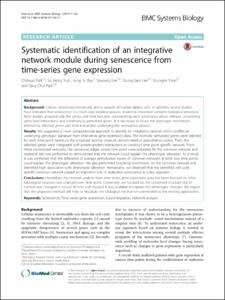Systematic identification of an integrative network module during senescence from time-series gene expression
- Title
- Systematic identification of an integrative network module during senescence from time-series gene expression
- Author(s)
- Park, Chihyun ; Yun, So Jeong ; Ryu, Sung Jin ; Lee, Soyoung ; Lee, Young-Sam ; Yoon, Youngmi ; Park, Sang Chul
- Issued Date
- 2017-03
- Citation
- BMC Systems Biology, v.11, no.1
- Type
- Article
- Author Keywords
- Senescence ; Time-series gene expression ; Data integration ; Network analysis
- Keywords
- Cancer ; Cellular Senescence ; Cyclin D1 ; Cytoscape ; Data Integration ; DNA Damage ; Network Analysis ; P27(KIP1) ; Protein ; Replicative Senescence ; Senescence ; Stem Cells ; Telomerase ; Time Series Gene Expression
- ISSN
- 1752-0509
- Abstract
- Background: Cellular senescence irreversibly arrests growth of human diploid cells. In addition, recent studies have indicated that senescence is a multi-step evolving process related to important complex biological processes. Most studies analyzed only the genes and their functions representing each senescence phase without considering gene-level interactions and continuously perturbed genes. It is necessary to reveal the genotypic mechanism inferred by affected genes and their interaction underlying the senescence process. Results: We suggested a novel computational approach to identify an integrative network which profiles an underlying genotypic signature from time-series gene expression data. The relatively perturbed genes were selected for each time point based on the proposed scoring measure denominated as perturbation scores. Then, the selected genes were integrated with protein-protein interactions to construct time point specific network. From these constructed networks, the conserved edges across time point were extracted for the common network and statistical test was performed to demonstrate that the network could explain the phenotypic alteration. As a result, it was confirmed that the difference of average perturbation scores of common networks at both two time points could explain the phenotypic alteration. We also performed functional enrichment on the common network and identified high association with phenotypic alteration. Remarkably, we observed that the identified cell cycle specific common network played an important role in replicative senescence as a key regulator. Conclusions: Heretofore, the network analysis from time series gene expression data has been focused on what topological structure was changed over time point. Conversely, we focused on the conserved structure but its context was changed in course of time and showed it was available to explain the phenotypic changes. We expect that the proposed method will help to elucidate the biological mechanism unrevealed by the existing approaches.
- Publisher
- BIOMED CENTRAL LTD
- Related Researcher
-
-
Lee, Young-Sam
- Research Interests DNA replication and repair; Restoration of cellular senescence; Structural and functional relationship of proteins
-
- Files in This Item:
-
 기타 데이터 / 2.3 MB / Adobe PDF
download
기타 데이터 / 2.3 MB / Adobe PDF
download
- Appears in Collections:
- Department of New Biology Senescence-Associated Mechanism Lab 1. Journal Articles



